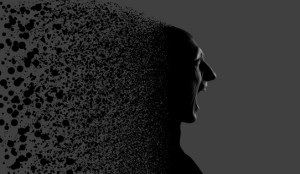The Whole-Half Self (Part 6)
By Asher Crispe: February 13, 2013: Category Inspirations, Thought Figures
Readings of R.D. Laing’s Existential Psychology
 No one wants to feel replaceable by another person much less an artificial image. We somehow sense when another is more infatuated with their mental picture or thoughts of us than our actual selves. According to Laing, this short selling of our real relationships is a byproduct of an underlying schism within the psyche: “The self can relate itself with immediacy to an object which is an object of its own imagination or memory but not to a real person.” (p.86) Extending this dilemma to our relationship with the Divine, we could reword it to stress our all too common difficultly in connecting with a real and ‘living’ God, where instead we relate only to a ‘dead’ historical image of Divinity–a God of my ancestors or of an ancient world but whose persona is behind the times, antiquated, or at the very least, non-contemporaneous.
No one wants to feel replaceable by another person much less an artificial image. We somehow sense when another is more infatuated with their mental picture or thoughts of us than our actual selves. According to Laing, this short selling of our real relationships is a byproduct of an underlying schism within the psyche: “The self can relate itself with immediacy to an object which is an object of its own imagination or memory but not to a real person.” (p.86) Extending this dilemma to our relationship with the Divine, we could reword it to stress our all too common difficultly in connecting with a real and ‘living’ God, where instead we relate only to a ‘dead’ historical image of Divinity–a God of my ancestors or of an ancient world but whose persona is behind the times, antiquated, or at the very least, non-contemporaneous.
Whenever we speak of a time in the past when God directly interacted with human beings, we are applying a kind of temporal distancing. For instance, statements like: ‘over 3000 years ago the Torah was given at Mount Sinai’ implies that this revelation was in the past and therefore arouses the question as to why this kind of grand scale miraculous display appears absent in the present. For those who are thus exclusively historically minded and a priori dismiss the possibility of a present ‘living’ relationship, all connections work through memory (which itself is a substitution that tries to make that which is formally absent present again).
All re/presentational images and mental pictures are themselves signaling a relationship that is transmitted with a delay (much like modern radio shows which have a delay of several seconds before the broadcast actually goes out so that they can be censored if need be). We notice this interval between ‘pre-recorded’ and ‘real-time.’ It changes our relationship to the ‘presence’ of the person who is there (or in this case, with the Divine Other). In a ‘real relationship’ in ‘real time’ we want an experience of intimacy that is not interrupted by the (excessive) imposition of our imagination and memory which might drive a wedge between ourselves and the other/Other which we are relating to.
Returning to his case study of this problem in the interpersonal realm, Laing documents the following situation:
“A patient, for instance, who conducted his life along relatively ‘normal’ lines outwardly but operated this inner split, presented as his original complaint the fact that he could never have intercourse with his wife but only with his own image of her. That is, his body had physical relations with her body, but his mental self, while this was going on, could only look on at what his body was doing and/or imagine himself having intercourse with his wife as an object of his imagination. He gave the guilt he was subjected to for doing this as a reason for seeking psychiatric advice.” (p.86)
Human beings have photovoltaic qualities–we get a charge out of light. The disclosure of an illuminated object to our power of vision seems to license our fashioning an image out of it. A sighting of an object feeds our imagination. In this way, we can begin to access the motivation behind one of the rabbinical guidelines for marital intimacy mentioned in the Code of Jewish Law (Shulchan Aruch Even Ha’ezer 25:5) which prescribes sexual relations in the dark. The psychology at work here is directly addressing the issue in Laing’s aforementioned case study. When all of the attention is to the visualization of the other, then the imagination may likely overpower our actual presence to the other. Instead of ‘being in the act’ we may become preoccupied with becoming an outside observer who cannot regain this original sense of presence.
The same immodesty is afoot in the production of an idol. Since the esoteric tradition is saturated with analogies of eroticism and sexuality, it follows that the inability to engage in direct intimate relations (in a spiritually abstract sense) with the Divine Other may be a function of improper associations which come from fixed (graven) images within our power of imagination (ko’ach hamedameh which, once again = 122 = eigel hazahav ‘Golden Calf’). Under such circumstances, a person is tempted by the desire to have something to visualize. Having relations with an unrepresentable God would amount to a union in the dark. Paradoxically we become most revealed to each other through this form of intentional concealment. In this way the other/Other would not be limited to my imagination (loosely speaking ‘reality is stranger than fiction’ in that the real holds a surplus of mystery and wonder that cannot be exhausted by the devices of fictional re/presentation). By keeping ‘us’ in the dark, our relationship is secured against ‘thinking too much about it’ which still turns out to be thinking too little or minimizing it within an inadequate conceptualization. Our being together would then altogether transcend the limits of thought and take on the infinite proportions of the super-rational.
Getting caught up in our mind jeopardizes our commitment to action (being-with or being-for the other/Other) and imperils creativity as Laing perspicaciously reports:
“The self, as long as it is ‘uncommitted to the objective element’, is free to dream and imagine anything. Without reference to the objective element it can be all things to itself – it has unconditioned freedom, power, creativity. But its freedom and its omnipotence are exercised in a vacuum and its creativity is only the capacity to produce phantoms. The inner honesty, freedom, omnipotence, and creativity, which the ‘inner’ self cherishes as its ideals, are cancelled, therefore, by a coexisting tortured sense of self-duplicity, of the lack of any real freedom, of utter impotence and sterility.” (p.89)
Having a self-conscious (Tree of Knowledge) fear of total commitment (Golden Calf) exacts a schism in the soul. We try to determine others (human and Divine) while eschewing our own fidelity to our relationship (as if stealing off with the image or idol of the other/Other would be a kind of psychosis as adultery, having a headstrong love interest and attachment to a [mental] portrait or statue rather than an real other/Other). While the sages place the greatest emphasis on the real (‘God wants a dwelling place in the lowest worlds,’ in the concrete plane of physical action and not just in our minds and hearts i.e. the upper worlds), a divided self partitions off this lowest level of existence and declares it false by insisting that: ‘I am not my actions; they do not define me.’ In Laing’s view:
“It can readily be understood why the schizoid individual so abhors action as characterized by Hegel. The act is ‘simple, determinate, universal…’. But his self wishes to be complex, indeterminate, and unique. The act is ‘what can be said of it’. But he must never be what can be said of him. He must remain always ungraspable, elusive, transcendent. The act is ‘such, and such…it is this, and the individual human being is what the act is’. But he must at all costs never be what his act is. If he were what his act was, then he would be helpless and at the mercy of any passer-by. ‘In the simple fact that the act is, the individual is for others what he really is’, but this again is precisely what he most fears might happen, and what he seeks to avoid by the use of a false self so that ‘he’ is never what he really is with others. ‘He’, his ‘self’, is endless possibility, capacity, intention. The act is always the product of a false self.” (p. 88)
 According to Laing, when a person feels threatened by the ‘determining’ gaze of the other (especially the Divine Other): “He tries therefore to forestall his own petrification by turning others into stones. By doing this he feels he can achieve some measure of safety.” (p.76) This description matches up with the ‘idolization’ drive as well. Divine omnipotency and omniscience is replaced with a Golden Calf which neither sees nor hears; it can do nothing to me. In Shemot/Exodus 32:20 when Moshe/Moses comes down from the mountain and finds the idol, he burns it and thereby nullifies its form. In this way, we can sense a parallel to the half shekel fire coin whose incompleteness and lack was all the more realized by its deconstructive combustion. Any semblance of completeness of the idol was destroyed as soon as it could no longer sustain its form as the fire consumed it. So too, by adding fire back into our relationships we can assure them greater vitality while breaking down the barriers to true intimacy forged in our imagination. In this way, the half shekel–the weighing of our incompleteness that requires a real other to make us whole–atones for the sin of the Golden Calf.
According to Laing, when a person feels threatened by the ‘determining’ gaze of the other (especially the Divine Other): “He tries therefore to forestall his own petrification by turning others into stones. By doing this he feels he can achieve some measure of safety.” (p.76) This description matches up with the ‘idolization’ drive as well. Divine omnipotency and omniscience is replaced with a Golden Calf which neither sees nor hears; it can do nothing to me. In Shemot/Exodus 32:20 when Moshe/Moses comes down from the mountain and finds the idol, he burns it and thereby nullifies its form. In this way, we can sense a parallel to the half shekel fire coin whose incompleteness and lack was all the more realized by its deconstructive combustion. Any semblance of completeness of the idol was destroyed as soon as it could no longer sustain its form as the fire consumed it. So too, by adding fire back into our relationships we can assure them greater vitality while breaking down the barriers to true intimacy forged in our imagination. In this way, the half shekel–the weighing of our incompleteness that requires a real other to make us whole–atones for the sin of the Golden Calf.
For Part Seven our attention will shift to the schizoid elements of the Purim story.















;)
;)
;)
;)
;)
;)
;)
;)
;)
;)
